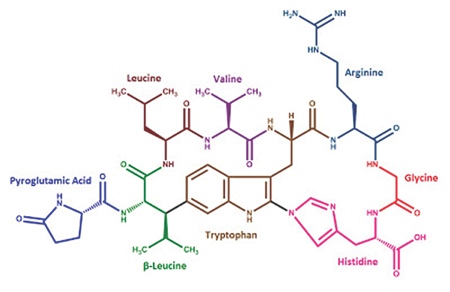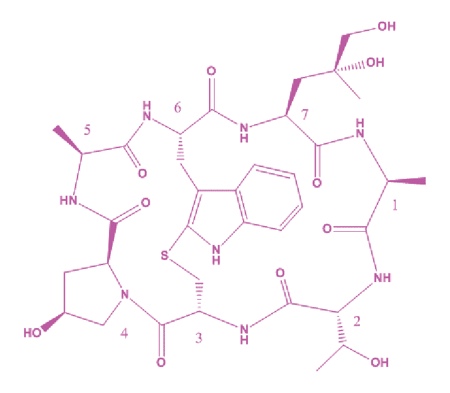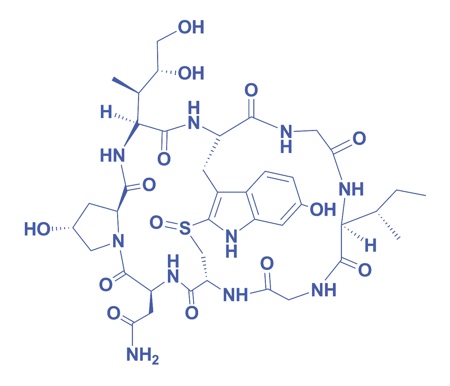Drugs approved by the Food and Drug Administration (FDA) or regulatory agencies worldwide fall under two main categories: small molecules; and biologics or large proteins. Both classes have limitations that restrict their functional range. Small molecules target human proteins bearing lipophilic pockets on their surface while large proteins and antibodies target through the exterior of the cell, so neither class interacts with the targets inside the cells. Small molecules and larger proteins together can access only 25% of cell targets; that leaves 75% of human proteins inside the cell that are not targeted by the two drug classes, making these cellular sites ‘undruggable’.
There is a great deal of interest among researchers to target these sites through the development of a novel therapeutic class, such as bicyclic peptides, that lie between the small molecule and monoclonal antibody (mAb) drug classes.
Bicyclic peptides may bind as tightly and specifically as antibodies, while being small enough to diffuse into tissues
Cyclic peptides are polypeptide chains whose amino and carboxyl termini are linked together with a peptide bond that forms a circular chain. Cyclic structures often exhibit improved stability, higher potency and bioavailability. Bicyclic peptides are polypeptides forming two circular units that have higher binding affinity and selectivity towards protein targets. The introduction of disulfide bridges provides rigidity to the molecule and increases its drug-like properties. Bicyclic peptides have a number of advantages over larger protein-based ligands in terms of chemical synthesis, and offer better tissue penetration and a wider choice of application routes.1
Potentially, bicyclic peptides can combine the favourable properties of both major classes of molecules and may bind as tightly and specifically as antibodies, while being small enough to diffuse into tissues. Due to their relatively rigid conformation, they can bind with high affinity and specificity to protein targets. Unlike linear peptides, they are significantly more stable and resistant to proteases in the blood circulation.
The number of amino acids in natural cyclic and bicyclic peptides varies from a few to hundreds. Based on the type of bonds in the cyclic and bicyclic peptides they are classified into two groups:
- Homodetic (cyclic and bicyclic) peptides – which contain bonds between the alpha carboxyl of one residue and the alpha amine of another, such as in cyclosporine A and malformin A.
- Heterodetic peptides – which contain disulfide bonds as well as covalent linkages with nonpeptide molecules such as acyl groups in oxytocin and Vancomycin.
Based on their cyclisation topology, homodetic peptides can be further classified as:
- Head to tail: Where the formation of the ring takes place by cyclisation between functional terminals of the amino and carboxyl group (Malformin A)
- Side chain to side chain: The cyclisation connects the side chain functional groups (α-Amanitin)
- Side chain to end: Amino or carboxyl group from the side chain links with ‘N’ or ‘C’ terminal of the amino acid, like that in cyclic isopeptides containing at least one non alpha amide linkage, as in microcystin.
- Backbone to backbone: Amide nitrogens of the peptide backbone are connected through a bridge with alkyl groups and an amide bond.
- Branched: Peptide chains are connected through lactams.
Depsipeptides are peptides in which one of the amide linkages is replaced by a lactone linkage. An example of this is aureobasidin A. Some cyclic and bicyclic depsipeptides are cyclised between the C-terminal carboxyl and the side chain of a Threonine or Serine residue. Bicyclic peptides, such as the amatoxins (amanitin) and phalloidin contain a bridging group, generally between two of the side chains. There are a number of cyclic peptide hormones that are cyclised through a disulfide bond between two cysteines, such as somatostatin and oxytocin.
There are several ways to generate potent bicyclic peptides, the most common being phage encoded libraries
There are several ways to generate potent bicyclic peptides, the most common being phage encoded libraries.5 To generate libraries of bicyclic peptides,2 Dr Christian Heinis and Sir Gregory Winter have developed phage strategies for disease targets; generation of potent phage followed by cyclisation of the phage encoded linear peptides containing three cysteine residues. The strategy was successfully applied to human plasma kallikrein inhibitors3,5 generated with nanomolar affinities.
Synthesis of cyclic and bicyclic peptides is complex. They have been prepared by solution phase and solid phase synthesis. Attention needs to be paid to high levels of orthogonolity and regioselectivity of amides when designing the synthetic schemes for bicyclic peptides. M. Teixido et al. describes in detail the various strategies involved in synthesis of bicyclic peptides.4 The solid phase synthetic approach towards bicyclic peptides has two protection schemes that are widely used: Boc/Bzl strategy (adapted with presence of sensitive groups) and the Fmoc/tert-Butyl chemistry, using piperidine and TFA respectively to remove these protecting groups.
The first approach has been successfully applied on thousands of peptides and the second one has been useful in introducing the orthogonality required in these complex bicyclic peptides. This is followed by a slow cyclisation step,6 which requires excess proportionality of reagents and optimisation of conditions. Phosphonium salts, (that can be used in excess without side reactions) are preferred over aminium reagent as the excess use of the aminium reagent can lead to the formation of guanidinio derivatives (reaction with amine). Solid phase cyclisations are carried out with PyBOP/HOBt/DIEA for 60 mins. Progress can be monitored by ninhydrin, MALDI and HPLC spectra (see Figure 1).
Libraries of bicyclic homodetic peptides are made using Fmoc/tert-Butyl based strategies where the first cycle is carried out in solid phase and the second is performed either in solid phase or in solution phase with the use of labile resins. However, the presence of D-amino acids and N-alkyl amino acids hinders the cyclisation process.
Bicyclic or polycyclic peptides can mimic large mAbs, but are much smaller in size
Monoclonal antibodies (mAbs) have shown high affinity and specificity toward biological structures with minimal damage to normal healthy cells. They have proved efficient in treatment of severe and chronic diseases such as cancer and autoimmune conditions. The fact that half of the top-selling drugs in 2011 and 2012 fall into this category shows its importance. The biggest limitation for mAbs is their large size; this makes their administration to patients complex and restricts their diffusion into tissues. Bicyclic or polycyclic peptides can mimic large mAbs, but are much smaller in size.
Bicyclic and polycyclic peptides may have better penetration and diffusion properties as well as wider choices of administration than mAbs. In comparison with small molecules, bicyclic and polycyclic peptides could have better target specificity with increased ability to disrupt protein-protein interactions. The only caveat is the difficulty in generating these mAbs peptides with suitable binding properties.
Some of the bicyclic peptides in clinical trials having 3–6 amino acids in each loop are 40–100 Å in size – ideal to intercept protein-protein interactions probably with high affinity. Because they are smaller than the antibodies, these peptides would easily penetrate target tissues. MMP (matrix metalloproteinase 14) involved in tumour metastasis is a good example. It has been demonstrated that bicyclic peptides screened against MMP14 take 40–60 mins for tumour tissue penetration, whereas mAbs take 12–20 hrs.7 There is also a need to explore larger molecules to tackle interaction sites too large for small molecules – bicyclic peptides are ideal for targeting such sites.
Examples of recent applications
Diagnostics use: Radiolabelled somatostatin analogues have been used to target somatostatin receptor (sst) tumours. Recently developed bicyclic somatostatin based radiopeptides are a new type of radiotherapy for neuroendocrine tumours and can be used as diagnostic imaging agents. These new analogues showed high affinity for sst2 and sst3 and moderate affinity towards sst1, sst4 and sst5.8 The analogue AM3, comprised of an octreotide ring and a head-to-tail coupled Arg-diaminobutyric acid (DOTA) ring, showed the highest receptor affinity and agonist potency. The pharmacokinetic data of 177Lu/68Ga-AM3 make this peptide an excellent candidate for imaging and as a PET radiotracer.
Another class of bicyclic peptides in the early stages of development are compounds targeting arginine-glycine-aspartic acid (RGD) vectors
Another class of bicyclic peptides in the early stages of development are compounds targeting arginine-glycine-aspartic acid (RGD) vectors that bind to the receptors associated with angiogenesis, such as integrin receptors, particularly the αvβ3 integrin receptor. These bicyclic compounds may be used for the diagnosis or treatment of malignancy, heart disease, endometriosis, inflammation-related diseases, rheumatoid arthritis and Kaposi’s sarcoma. The patent WO 03/006491 describes peptide-based compounds targeting integrin receptors associated with angiogenesis. EP1648925 European patent describes a new class of the bicyclic peptide and the analogues used as imaging agents.9
Histone acetyl transferase (HAT) and histone deacetylase (HDAC) are enzymes involved in balancing the dynamic process of acetylation and deacetylation of the amino groups of lysine at the N-terminal tails of the core histones. Imbalance in this process can bring about changes in the transcriptional regulation of genes involved in important functions such as differentiation and apoptosis. This may lead to disruption of this acetylation and deacetylation process, which can lead to carcinogenesis. Inhibition of HDAC enzymatic activity10 is expected to induce re-expression of differentiation-inducing genes. Several polypeptides have been reported as the inhibitors of HDAC enzymes, including the 3 depsipeptide Romidepsin, which has been approved for treatment of lymphoma and other cyclic peptides trapoxin (TPX), chlamydocin, HC-toxins and apicidin that are naturally occurring HDAC inhibitors trapoxin (TPX), chlamydocin, HC-toxins and apicidin that are naturally occurring HDAC inhibitors. Bicyclic peptides are used as HDAC inhibitors in cancer therapeutics and are involved in clinical trials.11
Plasma kallikrein – a serine protease implicated in hereditary angioedema: Bicyclic peptide antagonists of the serine protease plasma kallikrein3 inhibitors have potential application in hereditary angioedema, a life-threatening disease characterised by local swelling in subcutaneous tissue and organs.
Ionophores: Cyclic peptides can bind and transport metal cations across membranes in biological systems. Monocyclic peptides are too flexible and nonspecifically bind to metal ions, whereas bicyclic peptides are more rigid and specifically bind cations. A series of bicyclic peptides have been designed and synthesised by researchers to provide ammonium ion complexation sites via hydrogen bonding in a tetrahedral geometry. These bicyclic peptide ammonium ionophores selectively bind to the ammonium ions in the presence of potassium ions. This helps to determine the accuracy levels of ammonium ions in the presence of potassium ions for the clinical evaluation of urea and creatinine levels used in blood analysis applications.12
Bioactive bicyclic peptides: Bicyclic peptides form an important class of therapeutic agents with marketed products such as Actinomycin, endothelin, Vancomycin and Deoxybouvardin. A number of such compounds that therapeutically target HIV (Cycloviolin) and tumours (moroidin – Figure 2) are in early stage development.

Figure 2: Structure of the bicyclic peptide moroidin, an antitumour agent
The bicyclic octapeptide moroidin is a natural product found in stinging nettle (Urtica dioica) and is responsible for pain and rash on the skin.13 Moroidin has strong antimitotic activity as it inhibits tubulin polymerisation and thus interferes with cell division. Moroidin has two unusual bonds between β-leucine, tryptophan and histidine, shown as black bonds in Figure 2.
Another category of bicyclic peptides – peptide toxins – are capable of causing injury and disease when in contact with body tissues as they interact with biomolecules such as enzymes, hormones and cellular receptors. Toxins vary greatly in their severity, ranging from minor or acute reactions to fatal. Bicyclic peptide toxins can be used in the drug and diagnostic industry.
Theonellamide F: A novel antifungal bicyclic peptide from the marine sponge Theonella induces formation of vacuoles and over-production of 1, 3-beta-D-glucan. Theonellamide F inhibits growth of various pathogenic fungi (Candida spp., Trichophyton spp., and Aspergillus spp)14 and has cytotoxic properties against L1210 and P388 leukemia cells. Despite advances in technology and therapy, invasive fungal infections are still associated with significantly high morbidity and mortality in cancer patients. Most fungi contain polysaccharide component (1–3)-β-D-glucan in their cell wall. Theonellamide F can be used as an important biomarker for the measurement of antigens and the fungal wall component (1-3)-β-D-glucan; it can be used as a non-invasive method for detecting invasive fungal infections.
Phalloidin: This is a bicyclic heptapeptide that binds tightly to actin filaments and prevents their depolarisation. Actin polymerisation and depolymerisation are necessary for chemotaxis and cytokinesis in cells. Fluorescent phalloidin derivatives are useful in identifying the distribution of F-actin in cells (see Figure 3).

Figure 3: Phalloidin – a bicyclic peptide toxin
α-Amanitin: This bicyclic peptide of eight amino acids is the most deadly of all the toxins found in several species of the Amanita genus of mushrooms. It is known to inhibit RNA polymerase, which makes it a useful tool in determining types of RNA polymerase present in a tissue sample. RNA polymerase I, II, III and IV differ in their sensitivity towards α-Amanitin. RNA polymerase II and IV are the most sensitive, while RNA polymerase I and III are least sensitive to α-Amanitin.

Figure 4: Structure of the peptide toxin a-Amanitin; the deadliest of all toxins among the amanita genus
Researchers at the Ludwick Institute of Cancer Research in Germany have patented small, conformationally-constrained peptide inhibitors of the vascular endothelial growth factor (VEGF) family. Possible clinical applications include inhibition of the angiogenesis, lymphangiogenesis and neovascularisation to inhibit cancer growth, diabetic retinopathy and other chronic conditions. Dimeric bicyclic peptide inhibitors based on the sequences of exposed loops of growth factor proteins, such as loops 1, 2 and 3 of VEGF-D act as protein growth inhibitors and are useful antitumour agents.15
In conclusion, bicyclic peptides are an emerging class of drug molecules with some of the favourable properties possessed by small molecules and mAbs. Their size (macrocyclic loops) and functionality provide better specificity, binding properties, rigidity, stability and good tissue penetration. They have great potential as therapeutic drug candidates with low toxic profiles.
References
1. V. Baeriswyl , C. Heinis., ChemMedChem 2013;8(3), 377–84
2. Rentero Rebollo. I, Heinis. C, Methods 2013; 15; 60(1), 46–54
3. V. Baeriswyl, H. Rapley, L. Pollaro, et al., ChemMedChem. 2012 Jul; 7(7):1173–6
4. M .Teixidó, M.Altamira, L.Quartara, et al., J. Comb. Chem. 2003: 5, 760–768
5. C.Heinis, T.Rutherford , S. Freund, et al., Nat Chem Biol. 2009 Jul; 5(7):502–7
6. J.S. Davies, J. Peptide Sci. 9: 2003: 471–501
7. Kiran Nandra, OBR Review, 16 May 2013. On-line at www.oxbridgebiotech.com/review/featured/obr-london-therapeutic-use-of-monoclonal-antibodies-and-future-trends-in-biotherapeutics/
8. M.Fani, A. Mueller, M.L.Tamma, et al., J Nucl Med 2010; 51, 1771–1779
9. A.Cuthbertson, M. Solbakken, Imaging agents: World Patent WO 03/006491, European Patent EP1648925
10. N.M.Islam, T.Kato, N.Nishino, et al., Bioorganic & Medicinal Chemistry Letters 20 (2010) 997–999
11. H.J.Kim, S.C. Bae, Am. J. Transl. Res. 2011;3(2), 166-179
12. N .AI, A.Keller, E. Kolker, et al., Anal Chem. 2003 Sep 1;75(17):4646–58
13. H.Morita, K. Shimbo, H.Shigemori, et al., Bioorganic & Medicinal Chemistry Letters 10, 5, (2000), 469–471
14. S. Matsunaga , N. Fusetani , K.Hashimoto, et al., J. Am. Chem. SOC. 1989, 11, 1, 2582-2588
15. US patent :US 20020065218 A1, European Patent: EP 1248642 A1




